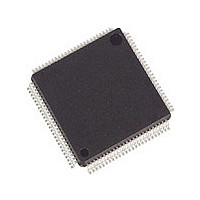AD8115AST Analog Devices Inc, AD8115AST Datasheet - Page 23

AD8115AST
Manufacturer Part Number
AD8115AST
Description
IC VIDEO CROSSPOINT SWIT 100LQFP
Manufacturer
Analog Devices Inc
Datasheet
1.AD8114ASTZ.pdf
(32 pages)
Specifications of AD8115AST
Rohs Status
RoHS non-compliant
Function
Video Crosspoint Switch
Circuit
1 x 16:16
Voltage Supply Source
Dual Supply
Voltage - Supply, Single/dual (±)
±4.5 V ~ 5.5 V
Operating Temperature
-40°C ~ 85°C
Mounting Type
Surface Mount
Package / Case
100-LQFP
Array Configuration
16x16
Number Of Arrays
1
Screening Level
Industrial
Pin Count
100
Package Type
LQFP
Power Supply Requirement
Dual
Lead Free Status / RoHS Status
Not Compliant
Available stocks
Company
Part Number
Manufacturer
Quantity
Price
Company:
Part Number:
AD8115AST
Manufacturer:
ADI
Quantity:
455
Company:
Part Number:
AD8115ASTZ
Manufacturer:
Analog Devices Inc
Quantity:
135
Company:
Part Number:
AD8115ASTZ
Manufacturer:
Analog Devices Inc
Quantity:
10 000
Part Number:
AD8115ASTZ
Manufacturer:
ADI/亚德诺
Quantity:
20 000
Measuring Crosstalk
Crosstalk is measured by applying a signal to one or more
channels and measuring the relative strength of that signal on a
desired selected channel. The measurement is usually expressed
as dB down from the magnitude of the test signal. The crosstalk
is expressed by
where s = jω is the Laplace transform variable, Asel(s) is the
amplitude of the crosstalk-induced signal in the selected
channel, and Atest(s) is the amplitude of the test signal. It can be
seen that crosstalk is a function of frequency, but not a function
of the magnitude of the test signal (to first order). In addition,
the crosstalk signal will have a phase relative to the test signal
associated with it.
A network analyzer is most commonly used to measure
crosstalk over a frequency range of interest. It can provide both
magnitude and phase information about the crosstalk signal.
As a crosspoint system or device grows larger, the number of
theoretical crosstalk combinations and permutations can
become extremely large. For example, in the case of the 16 × 16
matrix of the AD8114/AD8115, we can examine the number of
crosstalk terms that can be considered for a single channel, say
IN00 input. IN00 is programmed to connect to one of the
AD8114/AD8115 outputs where the measurement can be made.
First, we can measure the crosstalk terms associated with
driving a test signal into each of the other 15 inputs one at a
time while applying no signal to IN00. We can then measure the
crosstalk terms associated with driving a parallel test signal into
all 15 other inputs taken two at a time in all possible
combinations, then three at a time, etc., until there is only one
way to drive a test signal into all 15 other inputs in parallel.
Each of these cases is legitimately different from the others and
might yield a unique value depending on the resolution of the
measurement system, but it is hardly practical to measure all
these terms and then to specify them. In addition, this describes
the crosstalk matrix for just one input channel. A similar
crosstalk matrix can be proposed for every other input. In
addition, if the possible combinations and permutations for
connecting inputs to the other (not used for measurement)
outputs are taken into consideration, the numbers rather
quickly grow to astronomical proportions. If a larger crosspoint
array of multiple AD8114/AD8115s is constructed, the numbers
grow larger still.
XT
=
20
log
10
(
Asel
( )
s
Atest
( )
s
)
Rev. B | Page 23 of 32
Obviously, some subset of all these cases must be selected to be
used as a guide for a practical measure of crosstalk. One
common method is to measure all hostile crosstalk. This term
means that the crosstalk to the selected channel is measured
while all other system channels are driven in parallel. In general,
this will yield the worst crosstalk number, but this is not always
the case due to the vector nature of the crosstalk signal.
Other useful crosstalk measurements are those created by one
nearest neighbor or by the two nearest neighbors on either side.
These crosstalk measurements will generally be higher than
those of more distant channels, so they can serve as a worst-case
measure for any other 1-channel or 2-channel crosstalk
measurements.
Input and Output Crosstalk
The flexible programming capability of the AD8114/AD8115
can be used to diagnose whether crosstalk is occurring more on
the input side or the output side. Some examples are illustrative.
A given input channel (IN07 in the middle for this example)
can be programmed to drive OUT07 (also in the middle). The
input to IN07 is just terminated to ground (via 50 Ω or 75 Ω)
and no signal is applied.
All the other inputs are driven in parallel with the same test
signal (practically that is provided by a distribution amplifier),
with all other outputs except OUT07 disabled. Since grounded
IN07 is programmed to drive OUT07, no signal should be
present. Any signal that is present can be attributed to the other
15 hostile input signals because no other outputs are driven.
(They are all disabled.) Thus, this method measures the all-
hostile input contribution to crosstalk into IN07. Of course, the
method can be used for other input channels and combinations
of hostile inputs.
For output crosstalk measurement, a single input channel is
driven (IN00, for example) and all outputs other than a given
output (IN07 in the middle) are programmed to connect to
IN00. OUT07 is programmed to connect to IN15 (far away
from IN00), which is terminated to ground. Thus OUT07
should not have a signal present since it is listening to a quiet
input. Any signal measured at the OUT07 can be attributed to
the output crosstalk of the other 16 hostile outputs. Again, this
method can be modified to measure other channels and other
crosspoint matrix combinations.
AD8114/AD8115













